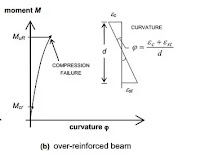Balanced, Under-Reinforced and Over-Reinforced Beam Sections
Reinforced concrete beams are classified as balanced, under-reinforced and over-reinforced based on percentage of reinforcement it has. Details of these beam sections are discussed.
Balanced, Under-Reinforced and Over-Reinforced Beam Sections
Moment of resistance of reinforced concrete beams are calculated based on following assumptions:
1. Plane sections remain plane in bending up to the point of failure. This means that strains are proportional to distance from the neural axis.
2. Ultimate limit state of bending failure is assumed to have been reached when the strain in the concrete at the extreme bending compression fiber reaches 0.0035
 |
| Strain diagram of a beam section; (a) Section, (b) Strain diagram |
3. The stress distribution across compression face will correspond to the stress-strain diagram for concrete in compression.
4. The tensile strength of concrete is neglected as the section is assumed to be cracked up to the neutral axis.
5. The stress in steel will correspond to the corresponding strain in the steel.
As given in assumption 2 above that the reinforced concrete section in bending is assumed to fail when the compression strain in concrete reaches the failure strain in bending compression equal to 0.0035.
Balanced Beam Section
Reinforced concrete beam sections in which the tension steel also reaches yield strain simultaneously as the concrete reaches the failure strain in bending are called balanced sections.
Under-Reinforced Beam Section
Reinforced concrete beam sections in which the steel reaches yield strain at loads lower than the load at which the concrete reaches failure strain are called under-reinforced sections.
Every singly reinforced beam should be designed as under-reinforced sections because this section gives enough warning before failure.
Yielding of steel in under-reinforced beam section does not mean the structure has failed, as when steel yields, excessive deflection and cracking in beam will occur before failure which gives enough time to occupants to escape before the section fails.
The failure in under-reinforced beam section is due to the concrete reaching its ultimate failure strain of 0.0035 before the steel reaches its failure strain which is much higher 0.20 to 0.25.
 |
Under-Reinforced Beam Section |
Over-Reinforced Beam Sections
Reinforced concrete beam sections in which the failure strain in concrete is reached earlier than the yield strain of steel is reached, are called over-reinforced beam sections.
If over-reinforced beam is designed and loaded to full capacity then the steel in tension zone will not yield much before the concrete reaches its ultimate strain of 0.0035. This due to little yielding of steel the deflection and cracking of beam does not occur and does not give enough warning prior to failure.
Failures in over-reinforced sections are all of a sudden. This type of design is not recommended in practice of beam design
 |
Over-Reinforced Beam Sections |
What is the difference between an over reinforced and under reinforced RCC beam?
To understand the difference between over reinforced and under reinforced, first we need to understand Balanced section.









No comments:
Post a Comment
If you are getting more information from civilengineerfriend page please give your comments. Share the page information in your whatsapp group. Subscribe our page to get more information.